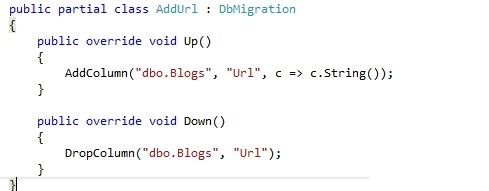在Code First中使用Migrations对实体类和数据库做出变更,Mirgration包含一系列命令。
工具--库程序包管理器--程序包管理器控制台
运行命令:Enable-Migrations 启用Code first Migration
运行成功后会产生两个类:Configuration.cs 和<timestamp>_InitialCreate.cs,这是一个用时间戳作为前缀的类。如201212310201487_InitialCreate.cs
然后更改实体类Blog,增加一个属性Url
public class Blog { public int BlogId { get; set; } public String Name { get; set; } public String Url { get; set; } public virtual List<Post> Posts { get; set; } }
运行命令:Add-Migration AddUrl,运行成功后会产生一个类:201212310209000_AddUrl.cs

运行命令:Update-Database,该命令运行成功后,更改属性将会映射到数据库。在SQL Server资源管理中刷新数据库查看变更。

6:Data Annotations
到目前为止我们使用EF发现实体类都是使用默认的行为,有很多行为不符合我们的要求,所以我们使用Data Annotations和 fluent API解决这个问题。
先添加一个User类,然后更新BlogContext:
public class User { public String Username { get; set; } public String DisplayName { get; set; } }
如果当前我们使用migration命令去变更数据库,则会提示错误:“EntityType ‘User’ has no key defined. Define the key for this EntityType”,因为EF没有办法知道Username应该是User表的主键,在Program顶部添加代码:using System.ComponentModel.DataAnnotations; 然后给Username属性添加属性Key
public class User { [Key] public String Username { get; set; } public String DisplayName { get; set; } }
运行命令:Add-Migration AddUser将变更映射到数据库。运行成功后会产生一个类:201212310235372_AddUser.cs
public partial class AddUser : DbMigration { public override void Up() { CreateTable( "dbo.Users", c => new { Username = c.String(nullable: false, maxLength: 128), DisplayName = c.String(), }) .PrimaryKey(t => t.Username); } public override void Down() { DropTable("dbo.Users"); } }
运行命令:Update-Database将新的迁移映射到数据库,此时查看数据库会产生User表。
7、Fluent API
如果我们需要更变列名,则使用FluentAPI, 如果我们需要把User表的DisplayName改为Display_name.在BlogContext中重写OnModelCreating:
protected override void OnModelCreating(DbModelBuilder modelBuilder){ modelBuilder.Entity<User>() .Property(u=>u.DisplayName) .HasColumnName("Display_name");}
运行命令:Add-Migration ChangeDisplayName.
运行命令:Update-Database.
查看User表已更新字段Display_name.